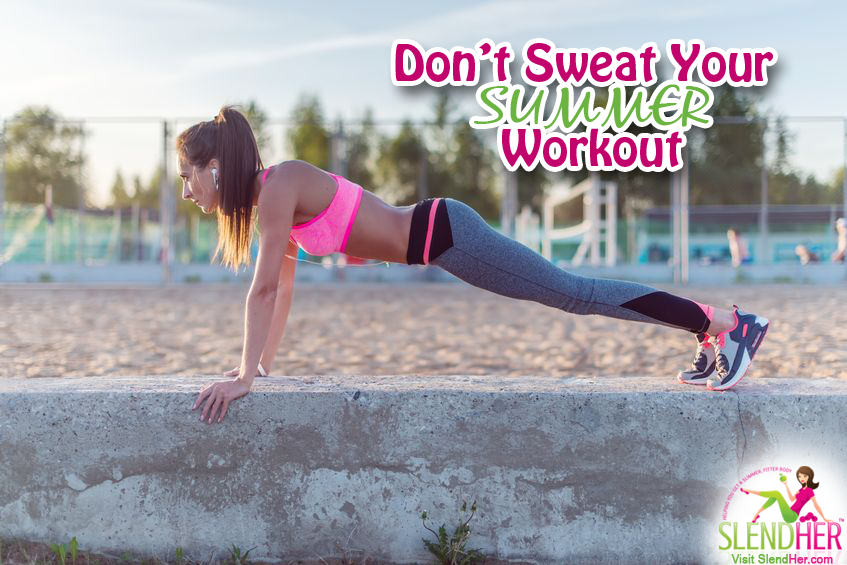
Mother Nature loves to set summer workouts ablaze. While you can move your fitness indoors when the mercury rises outdoors, the A/C doesn’t have to be the only way to stay cool during your next sweat session. Plus, turning up the heat a bit while you exercise comes with a few benefits.
Summer Workout Benefits
While it may not be the most comfortable workout, training in the heat can have its benefits when done in a safe way. According to a 2012 New Zealand study published in the European Journal of Applied Physics, athletes tested…
- found higher blood plasma volume, which can boost cardio fitness.
- were better able to acclimate to hot temperatures, and contrary to common sense, found improved cold weather training.
- experienced reduced blood lactate, which means less muscle burn when working out.
Don’t Get Burned by Your Summer Workout

Benefits be as they may, when you’re hot, you’re hot. And while that may seem ideal for a ladies’ night out on the town, it’s not so fun when you’re trying to fit in your fitness. Before you stay indoors with the air blasted on high and all fans pointed your way, give the following summer workout tips a try to help beat the heat without avoiding it.
- Time it right: When humidity levels rise, it can feel like trying to breathe underwater. And when the heat index spikes, the warmth can be too hot to handle safely. Since the hottest time of the day is often between noon and 3 p.m., it’s best to schedule your exercise earlier in the morning or closer to the evening to avoid the extreme heat. If midday is your only option, safety is of utmost importance. Avoid working out in direct sunlight and move to shadier areas instead. Also, get acclimated to the heat. Start slowly, walking before jogging before running before sprinting, for example.
- Keep sweating: Perspiration helps to keeps the body cool two ways. The first is wet skin helps your body to feel cool versus when it’s dry. Second, when sweat evaporates off your skin, it takes a bit of body heat with it. When the air is dry, let the sweat evaporate to feel more comfortable. You can also use a misting bottle to help dampen your skin. However, when humidity is up, your sweat has nowhere to go. Help send it on it’s way with moisture-wicking clothing that can be more comfortable than cotton clothing, which can become heavy with water and no fun to wear when working out.
- Drink up: Remember that the more you sweat, the more dehydrated your body can become. Dehydration can lead to dizziness and headaches, and is a good sign you need to drink up, take a break, and get out of the heat. If you notice you are not sweating at all, but are exerting increased effort in the heat, take that as another sign that your body needs hydration. Consider packing ice and water in bottles or in a hydration backpacks to sip on often throughout your workout.
- Top it off: Hats trap heat, which is why knit beanies are worn in the winter to stay warm. However, some hats, especially those made with mesh vents and lightweight, moisture-wicking material, can help to keep the sun’s heat off your head. When choosing head cover, look for ones engineered for evaporative heat loss or ones with broad rims to keep the sun off your head, as well as neck and shoulders. If you feel your head heating up with a hat on, keep the material wet (barring certain types of hats, that is) to chill out from the top down.
- Cool styles to wear: In addition to wearing moisture-wicking material on your noggin to decrease the heat, consider make it the mainstay of your hot-weather workout wear. Also, skip the black. As slimming as it may make you look, it holds the heat and can make you feel hotter than when wearing white or lighters color. And since every good outfit needs accessories, consider neck scarves designed with cooling gel or bandannas soaked in ice water and worn around the neck or on the head.
- Slather on protection: You likely well know the necessity of sunscreen to not only deter skin damage but also prevent sunburn. And that’s important to keeping you cool, as a sunburn–even in air-conditioned indoors–can make you feel like the heat is on. Avoid getting scorched by wearing waterproof (i.e., sweat-proof) sunscreen, and preferably one that includes a cooling agent. Up the chill by storing it in the refrigerator prior to applying.
Stay Safe with Your Summer Workout
While all of these tips can help you stay cool, extreme summer heat and exercise sometime just don’t always mix. It’s better to play it safe by working out indoors or scaling back the intensity. Heat stroke and other heat-related ailments are no joke. Even when you start to feel better, your body may not be fully recovered as you think. Proceed with caution.
How do you stay cool during the summer? Share with others in the comments!

Leave a Reply